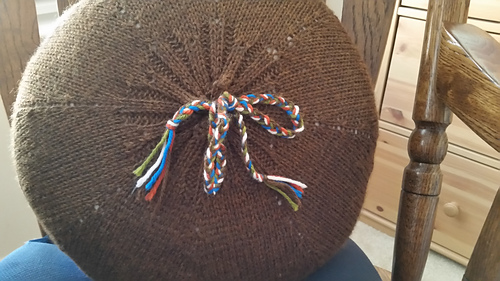patterns >  Mary G Knits
Mary G Knits
> Southwest Salsa - Set of 4 pillows











Southwest Salsa - Set of 4 pillows
These pillows are based on traditional Navajo and Southwest aboriginal weaving designs. The colors I used are those often seen in these weavings – dark red, brown, dusty black, sage green, turquoise, sunburnt orange and a natural white. The Navajo, whose blanket weaving was heavily influenced both by the immigration of Spanish settlers as well as the other Anglos who came to settle the West, have created a beautiful fiber tradition with these blankets (which they use for sleeping as well as outerwear). Navajo weaving can be split into three distinct “periods”:
- The classic period: 1650-1865
- The transition period: 1865-1895
- The modern period: 1895 to the present
I’ve used these different periods for my pillow designs, imitating many of the motifs found in the classic and transition periods. The round pillow is particularly dedicated to the “Spider Woman”: in Navajo tradition, the Spider Woman is a spirit-woman who taught the Navajo how to weave to keep themselves warm.
For further information about the Navajo weaving traditions, please see:
Navajo Weaving: Three Centuries of Change by Kate Peck Kent (an excellent academic reference work) as well as the following websites: http://weavinginbeauty.com, http://www.nps.gov/hutr/ (check out the photos of the museum’s collection), and http://www.navajotextiles.com/ .
1 set US #7/4.5mm double-point needles (directions assume 5 needles in a set)
1 set US #7/4.5mm circular needle (24” length)
notions required:
• 10 half-inch buttons (for closure on bolster pillow)
• pillow-forms: 16-inch round, 16-inch square, 12x16-inch rectangle, and 6x15” bolster
• stitch markers
• large-eyed tapestry needle for hiding ends
• sewing needle and thread for attaching buttons
PATTERN NOTES
• all pillow tops have been designed to be easily removed for cleaning; follow label directions for machine-washing/drying to ensure longevity of these classic pillows
• all but the rectangle pillow start from a center “loop CO” – make a loop on your thumb, holding closed with your pointer finger; make as if to knit into circle and put st on needle, purl into circle and put st on needle rep for number of sts required. Join. After a couple of rounds, pull yarn end to close CO circle; on ws, make an overhand knot near to center sts to secure.
• the rectangle pillow is knit in the round with the bottom stitched together and a fold-over flap with braided ties to keep closed. The pillow can be displayed with this flap to the front or to the back.
• Color-work is charted for ease in knitting. The pillow tops are knit in the round and the yarn is stranded across the back.
81896 projects
stashed
45627 times
- First published: March 2018
- Page created: March 3, 2018
- Last updated: March 3, 2018 …
- visits in the last 24 hours
- visitors right now




